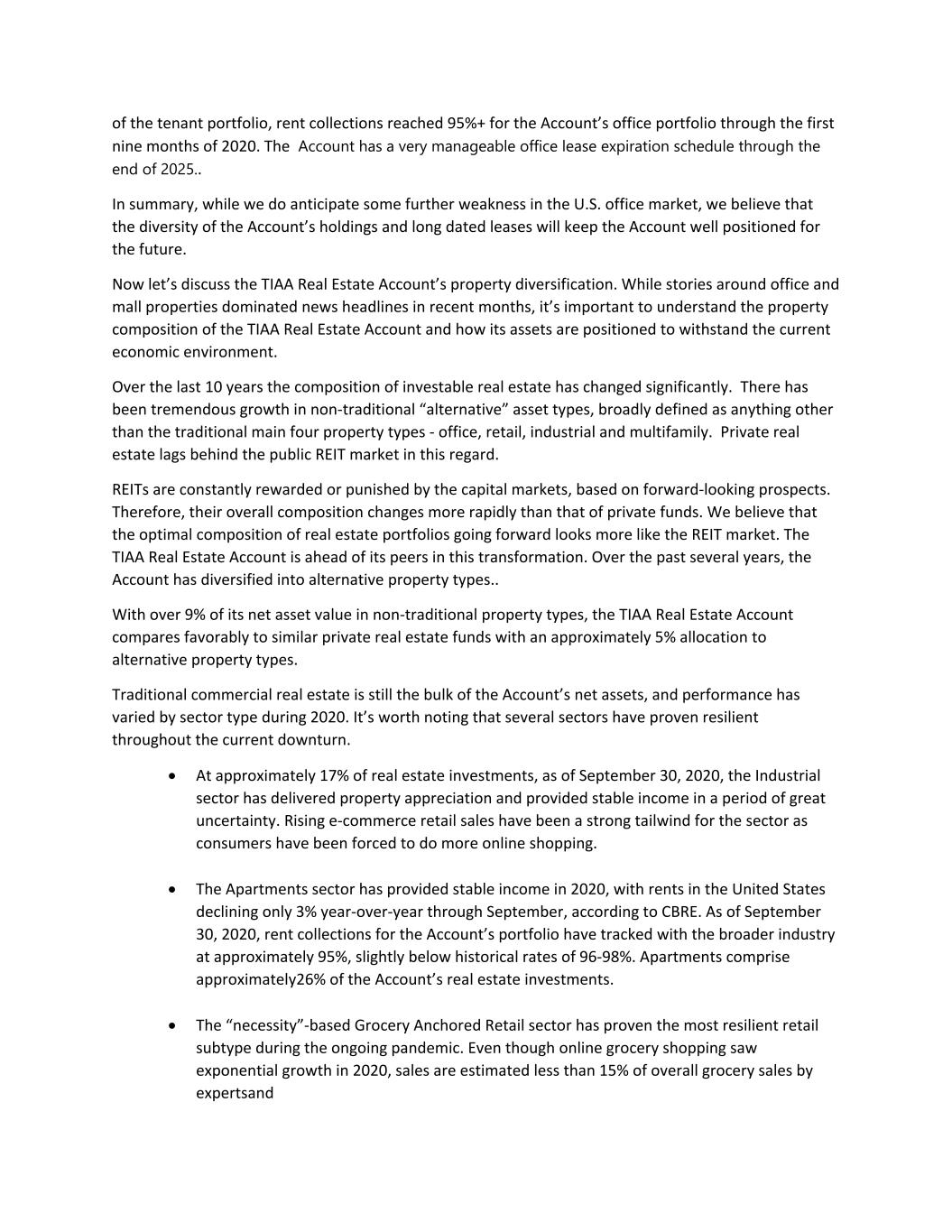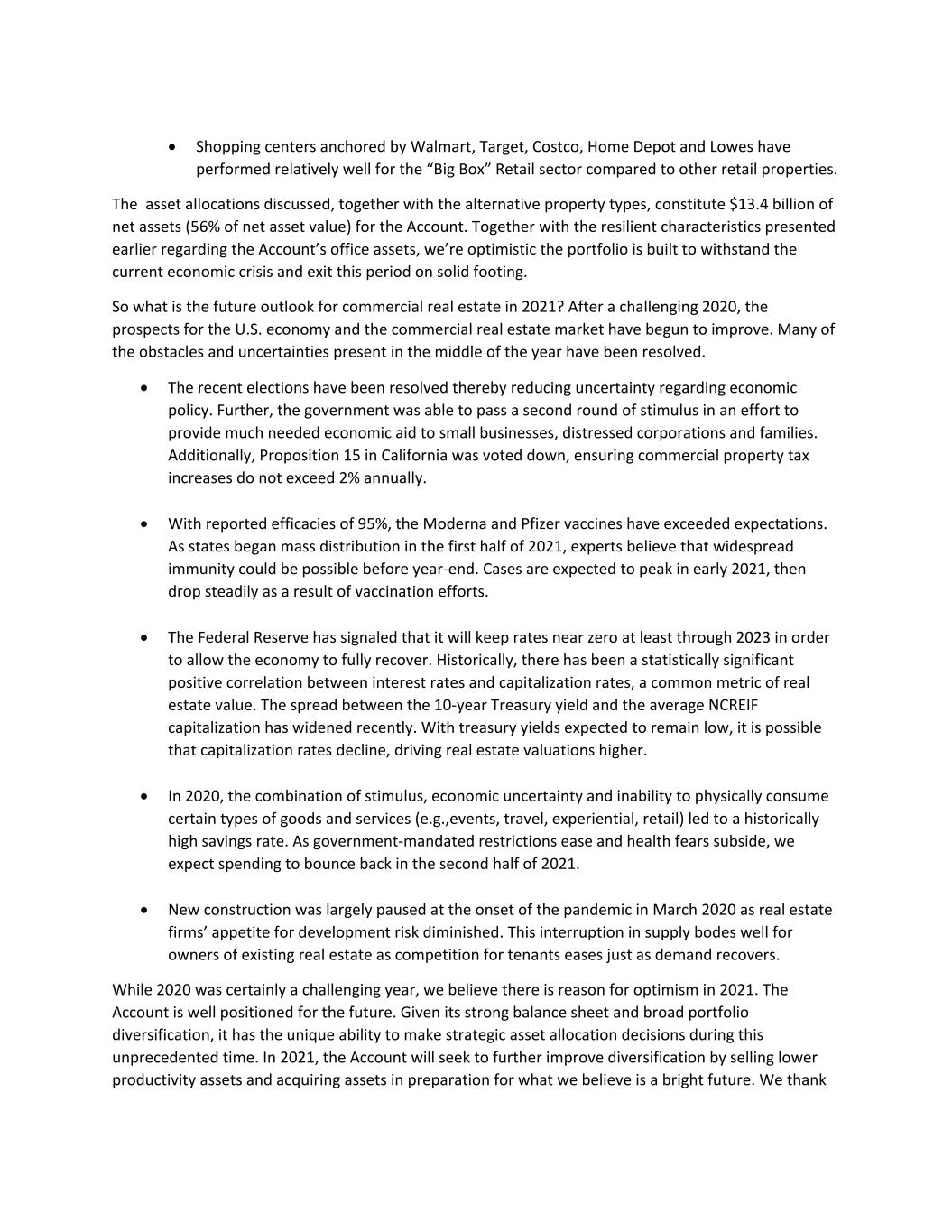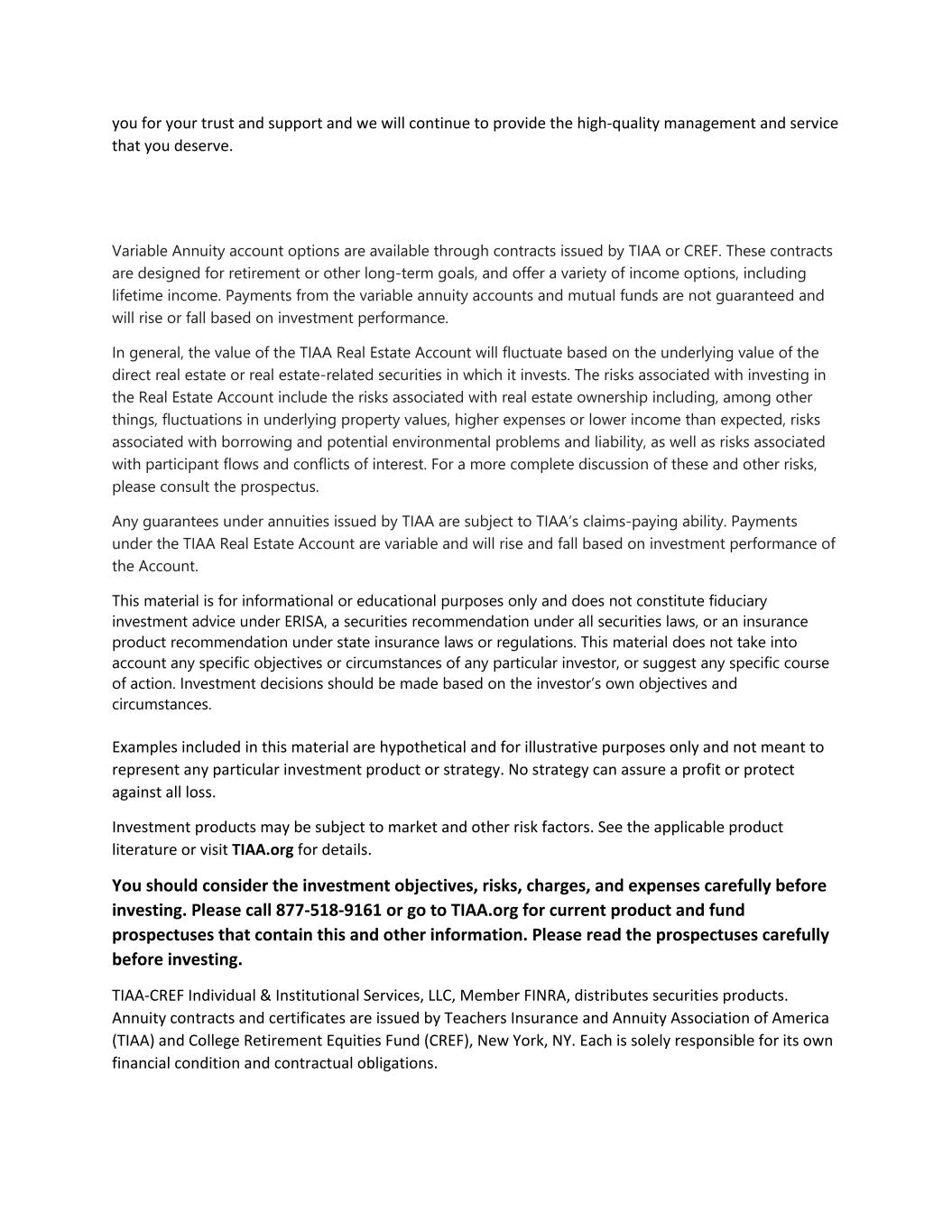Attached files
| file | filename |
|---|---|
| EX-99.1 - EX-99.1 - TIAA REAL ESTATE ACCOUNT | ex991reaoutlookletter.htm |
| 8-K - 8-K - TIAA REAL ESTATE ACCOUNT | a2021reaoutlookletterwrapp.htm |

REA Outlook Podcast Script Throughout 2020, the world experienced an unprecedented global health crisis and resulting economic crisis that hasn’t been seen in over 100 years. The economic impact will be felt for years to come and recovery is expected to be uneven across sectors. However, by the end of the year, there were several reasons for optimism, including: election uncertainty subsiding, federal law makers passing a second round of stimulus, and better than expected COVID-19 vaccine news. Commercial real estate, relative to other asset classes, experienced greater adverse effects by the ongoing pandemic but we continue to be optimistic about the future of real estate. Our discussion will focus on three items: • Work from home implications for the office sector • The TIAA Real Estate Account’s property diversification • Future Outlook for commercial real estate in 2021 With traditional office workers continuing to work remotely as we began 2021, the relevancy of the physical office space has come into question. A recent survey of 50,000 office workers, conducted by Cushman & Wakefield in November, found that 73% of them “want remote working policies expanded and a shift to balancing office, home and third places.” While the long-term impacts to office demand are unknown, the general consensus is that workers will demand greater flexibility, ultimately driving a reduction in demand for physical office space. This trend will be somewhat offset by the need for more space per office employee. Most tenants have chosen a “wait and see” approach to near-term lease expirations. As leases expired in 2020, U.S. tenants of the Real Estate Account have generally signed short-term extensions instead of locking in longer-term deals. The next few years will likely be challenging for the office sector overall but certain characteristics of the Account, and the sector in general, provide reason for optimism. , The broad diversification of the Account’s office portfolio across a number of markets and industries, largely mitigate geographic concentration and tenant risk. Another important point is there are numerous sub-sectors within the broader office market. For example, the Life Sciences sub-sector, a mix of office and laboratory space, has experienced rapid growth in recent years and was a strong performer in commercial real estate markets in 2020. The TIAA Real Estate Account has approximately $1.1 billion (12% of the office portfolio) in the Life Sciences sub- sector as of September 30, 2020. Notable tenants include Biogen, Eli Lilly and Fibrogen. The Medical Office sub-sector is another area of opportunity for the Account. In the fourth quarter, the Account established a joint venture with Healthcare Realty, a leading real estate investment trust (REIT) in the sub-sector, with the purpose of acquiring a diverse portfolio of assets over the next few years. One of the main benefits of office investments is their longer lease terms. Unlike apartments, which typically have 1-year durations, office leases tend to have terms ranging from 5 to 10 years. The weighted average lease terms of the Account’s office portfolio is 5.9 years as of September 30, 2020. This helps secure cash flow during periods of uncertainty and disruption. Factoring in the credit quality Exhibit 99.2

of the tenant portfolio, rent collections reached 95%+ for the Account’s office portfolio through the first nine months of 2020. The Account has a very manageable office lease expiration schedule through the end of 2025.. In summary, while we do anticipate some further weakness in the U.S. office market, we believe that the diversity of the Account’s holdings and long dated leases will keep the Account well positioned for the future. Now let’s discuss the TIAA Real Estate Account’s property diversification. While stories around office and mall properties dominated news headlines in recent months, it’s important to understand the property composition of the TIAA Real Estate Account and how its assets are positioned to withstand the current economic environment. Over the last 10 years the composition of investable real estate has changed significantly. There has been tremendous growth in non-traditional “alternative” asset types, broadly defined as anything other than the traditional main four property types - office, retail, industrial and multifamily. Private real estate lags behind the public REIT market in this regard. REITs are constantly rewarded or punished by the capital markets, based on forward-looking prospects. Therefore, their overall composition changes more rapidly than that of private funds. We believe that the optimal composition of real estate portfolios going forward looks more like the REIT market. The TIAA Real Estate Account is ahead of its peers in this transformation. Over the past several years, the Account has diversified into alternative property types.. With over 9% of its net asset value in non-traditional property types, the TIAA Real Estate Account compares favorably to similar private real estate funds with an approximately 5% allocation to alternative property types. Traditional commercial real estate is still the bulk of the Account’s net assets, and performance has varied by sector type during 2020. It’s worth noting that several sectors have proven resilient throughout the current downturn. • At approximately 17% of real estate investments, as of September 30, 2020, the Industrial sector has delivered property appreciation and provided stable income in a period of great uncertainty. Rising e-commerce retail sales have been a strong tailwind for the sector as consumers have been forced to do more online shopping. • The Apartments sector has provided stable income in 2020, with rents in the United States declining only 3% year-over-year through September, according to CBRE. As of September 30, 2020, rent collections for the Account’s portfolio have tracked with the broader industry at approximately 95%, slightly below historical rates of 96-98%. Apartments comprise approximately26% of the Account’s real estate investments. • The “necessity”-based Grocery Anchored Retail sector has proven the most resilient retail subtype during the ongoing pandemic. Even though online grocery shopping saw exponential growth in 2020, sales are estimated less than 15% of overall grocery sales by expertsand

• Shopping centers anchored by Walmart, Target, Costco, Home Depot and Lowes have performed relatively well for the “Big Box” Retail sector compared to other retail properties. The asset allocations discussed, together with the alternative property types, constitute $13.4 billion of net assets (56% of net asset value) for the Account. Together with the resilient characteristics presented earlier regarding the Account’s office assets, we’re optimistic the portfolio is built to withstand the current economic crisis and exit this period on solid footing. So what is the future outlook for commercial real estate in 2021? After a challenging 2020, the prospects for the U.S. economy and the commercial real estate market have begun to improve. Many of the obstacles and uncertainties present in the middle of the year have been resolved. • The recent elections have been resolved thereby reducing uncertainty regarding economic policy. Further, the government was able to pass a second round of stimulus in an effort to provide much needed economic aid to small businesses, distressed corporations and families. Additionally, Proposition 15 in California was voted down, ensuring commercial property tax increases do not exceed 2% annually. • With reported efficacies of 95%, the Moderna and Pfizer vaccines have exceeded expectations. As states began mass distribution in the first half of 2021, experts believe that widespread immunity could be possible before year-end. Cases are expected to peak in early 2021, then drop steadily as a result of vaccination efforts. • The Federal Reserve has signaled that it will keep rates near zero at least through 2023 in order to allow the economy to fully recover. Historically, there has been a statistically significant positive correlation between interest rates and capitalization rates, a common metric of real estate value. The spread between the 10-year Treasury yield and the average NCREIF capitalization has widened recently. With treasury yields expected to remain low, it is possible that capitalization rates decline, driving real estate valuations higher. • In 2020, the combination of stimulus, economic uncertainty and inability to physically consume certain types of goods and services (e.g.,events, travel, experiential, retail) led to a historically high savings rate. As government-mandated restrictions ease and health fears subside, we expect spending to bounce back in the second half of 2021. • New construction was largely paused at the onset of the pandemic in March 2020 as real estate firms’ appetite for development risk diminished. This interruption in supply bodes well for owners of existing real estate as competition for tenants eases just as demand recovers. While 2020 was certainly a challenging year, we believe there is reason for optimism in 2021. The Account is well positioned for the future. Given its strong balance sheet and broad portfolio diversification, it has the unique ability to make strategic asset allocation decisions during this unprecedented time. In 2021, the Account will seek to further improve diversification by selling lower productivity assets and acquiring assets in preparation for what we believe is a bright future. We thank

you for your trust and support and we will continue to provide the high-quality management and service that you deserve. Variable Annuity account options are available through contracts issued by TIAA or CREF. These contracts are designed for retirement or other long-term goals, and offer a variety of income options, including lifetime income. Payments from the variable annuity accounts and mutual funds are not guaranteed and will rise or fall based on investment performance. In general, the value of the TIAA Real Estate Account will fluctuate based on the underlying value of the direct real estate or real estate-related securities in which it invests. The risks associated with investing in the Real Estate Account include the risks associated with real estate ownership including, among other things, fluctuations in underlying property values, higher expenses or lower income than expected, risks associated with borrowing and potential environmental problems and liability, as well as risks associated with participant flows and conflicts of interest. For a more complete discussion of these and other risks, please consult the prospectus. Any guarantees under annuities issued by TIAA are subject to TIAA’s claims-paying ability. Payments under the TIAA Real Estate Account are variable and will rise and fall based on investment performance of the Account. This material is for informational or educational purposes only and does not constitute fiduciary investment advice under ERISA, a securities recommendation under all securities laws, or an insurance product recommendation under state insurance laws or regulations. This material does not take into account any specific objectives or circumstances of any particular investor, or suggest any specific course of action. Investment decisions should be made based on the investor’s own objectives and circumstances. Examples included in this material are hypothetical and for illustrative purposes only and not meant to represent any particular investment product or strategy. No strategy can assure a profit or protect against all loss. Investment products may be subject to market and other risk factors. See the applicable product literature or visit TIAA.org for details. You should consider the investment objectives, risks, charges, and expenses carefully before investing. Please call 877-518-9161 or go to TIAA.org for current product and fund prospectuses that contain this and other information. Please read the prospectuses carefully before investing. TIAA-CREF Individual & Institutional Services, LLC, Member FINRA, distributes securities products. Annuity contracts and certificates are issued by Teachers Insurance and Annuity Association of America (TIAA) and College Retirement Equities Fund (CREF), New York, NY. Each is solely responsible for its own financial condition and contractual obligations.

©2020 Teachers Insurance and Annuity Association of America-College Retirement Equities Fund, 730 Third Avenue, New York, NY 10017 1470722
